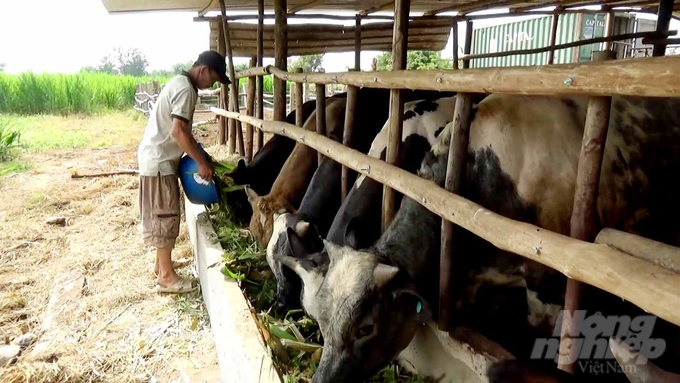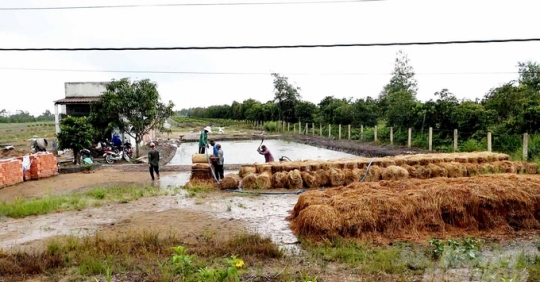In our country, agricultural by-products are considered a rich and potentially renewable resource. When done well, converting agricultural by-products into other valuable products helps minimize environmental impact, reduce greenhouse gas emissions, and improve economics for businesses and farmers.
Too much waste of by-products
Farmer Nguyen Van Duc (Chau Duc District, Ba Ria – Vung Tau) shared this situation and said that he fertilizes his garden with organic fertilizer made from cocoa pods at the beginning and end of the rainy season, with each root weighing about 25–30 kg in a year. As a result, his family’s cocoa garden is always green and he saves 30% of the costs. Despite their effectiveness, most cocoa pods are still considered garbage after harvest and are disposed of, putting a strain on the environment.

Most cocoa pods are still considered garbage after harvest and are disposed of, polluting the environment. Picture: Le Binh.
Not just cocoa, the Southeast region alone has almost 14 million tons of agricultural by-products, of which 7.8 million tons come from cultivation and 6 million tons from cattle manure. Currently, in the Ho Chi Minh City area, the by-products of agricultural production are not fully utilized, wastes such as coconut fibers, bagasse, bean scraps, durian shells…
There were cooperatives that boldly collected by-products of agricultural production to be processed as organic fertilizer and used as a biological buffer in livestock and as compost for animal feed. However, the collection and processing of this resource still faces many methodological and technological difficulties.
Ms. Pham Thi Thu Ha, Director of Vu Hung Truong Hi-Tech Agricultural Cooperative (Binh Hung Hoa District, Binh Tan District, Ho Chi Minh City) said: “Recently, the cooperative has worked with units to collect and process agricultural by-products as biological cushions for chicken and pig farms. In reality, however, there are still many difficulties, we hope that the local authorities will create favorable conditions for the cooperative to collect agricultural by-products, increase income and create jobs for workers while protecting the environment.”
In fact, there are many problems in implementing circular economy, typically in the livestock “capital” of Dong Nai province. Mr. Nguyen Tri Cong, chairman of the Dong Nai Livestock Association, said many cow breeders who go to agricultural processing factories to buy by-products for food have faced transportation problems because they fail to comply with the environmental protection law. Cow manure and pig manure, on the other hand, are also very difficult to transport.

The value that agricultural by-products bring is great, but cooperatives and companies face many difficulties in using them effectively. Picture: Le Binh.
According to experts, the value brought by agricultural by-products is great, but effective utilization faces many difficulties. In particular, the process of collecting, preserving and processing agricultural by-products has not been specified; there is no legal framework for the recycling of agricultural by-products and the implementation of circular agriculture; the connection of the model of using by-products with the value chain of agricultural products is still open…
In the past there have also been many strategies for exploiting and treating agricultural by-products in the agricultural sector, but this is still not close to reality, especially in the non-specific action plan, where the main force is a company that does not yet have a driving force. The role of farming associations and farming advice is also unclear, leading to fragmented models of performance with no continuity.
A development policy is needed
Nguyen Van Bac, deputy chief of the Southern Office (National Center for Agricultural Extension), circular economy is the agricultural production process in a closed loop, waste and by-products of this process are the input for other production processes, through the application of scientific and technical advances, as well as biotechnology and physical -chemical solutions. As a result, agricultural production will use and utilize resources economically and efficiently, minimize waste and post-harvest losses, create safe, high-quality products, and most importantly, move to the next goal, eliminate polluting waste, reduce greenhouse gas emissions, protect the ecosystem and human health.

The potential and value of agricultural by-products in our country is great. Picture: Minh Sang.
The potential and value of agricultural by-products in our country is great. Annually, the biomass of agricultural by-products from main crops such as rice, corn, sugar cane, vegetables of all kinds can provide the equivalent of 43 million tons of organic fertilizer, 1.8 million tons of urea, 1.6 million tons of monosuperphosphate and 2.2 million tons of potassium sulfate. This is considered a great renewable resource to offset soil nutrients and use for agricultural crops, but most of this nutrient is wasted.
“In order to ensure long-term and sustainable effectiveness in recycling agricultural by-products, it is necessary to further promote propaganda and raise awareness of circular economy in agriculture among administrative authorities, business communities and farmers. Places, farms and people should also develop and scale up models of good agricultural practices, organic farming and circular economy,” said Dr. Nguyen Van Bac.
According to Mr. Dinh Minh Hiep, director of the Ministry of Agriculture and Rural Development of Ho Chi Minh City, the city now has many policies to help companies and cooperatives participate in the circular production process to utilize agricultural by-products. , such as B. Measures to support enterprises in technological innovation from abroad, promoting the transfer of effective research results from models from universities and institutes to cooperatives, as well as enterprises, while focusing on loan interest promotion measures that enterprises can invest and implement their projects.
“There are currently many by-products in both agriculture and the processing industry. If we use the treatment to produce animal feed or organic fertilizers, it is very good to move towards the development of organic agriculture. organic farming in a broader sense,” said Mr. Hiep.

At present, agricultural by-products are quite a lot, when used to produce animal feed or as organic fertilizer, it brings great economic benefits. Picture: Minh Sang.
According to the Ministry of Agriculture and Rural Development, the total source of agricultural by-products in our country is currently about 160 million tons per year, of which about 90 million tons are by-products after harvesting and processing of agricultural products, 62 million tons are cattle and poultry manure from the animal husbandry…
However, this valuable resource is wasted when almost 46% of the dried straw and fruit skins are incinerated; Only 23% of livestock waste was used to produce organic fertilizer. Meanwhile, by-products from seafood processing are only used as fishmeal, collagen, gelatin… the value achieved is not much compared to the potential.
Experts say that if done well, the source of organic fertilizer will increase to 40 million tons by 2025 and 50 million tons by 2030. This is a step that must be completed soon as Vietnam develops a circular agricultural economy associated with green growth, while promoting the economy from by-products that can generate high added value.
“Some communities have not yet addressed waste management, agricultural by-products, or training and technical guidance for production facilities. Therefore, only about 10% of crop residues are now available. The harvest is used on site as fuel, 5% as industrial fuel, 3% as animal feed and more than 80% goes unused and is directly discharged into the environment or incinerated, leading to environmental pollution,” said Dr Extension.

